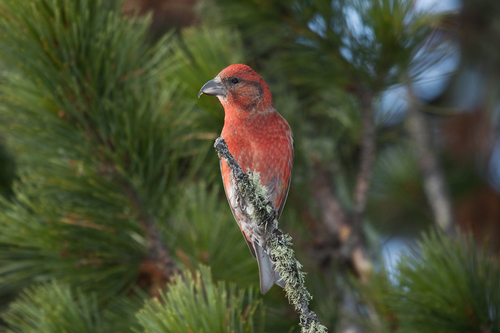
Red Crossbill
The Red Crossbill (Loxia curvirostra) is a fascinating and unique species of finch, renowned for its distinctive crossed bill, an adaptation perfectly suited for extracting seeds from conifer cones. This specialized feeding behavior makes them highly dependent on coniferous forests and drives their nomadic movements, often irrupting into new areas in search of abundant cone crops. They play a crucial role in their ecosystem by dispersing seeds and influencing forest regeneration. While not typically considered a bird with significant cultural symbolism, their unusual appearance and erratic movements have long intrigued birdwatchers and ornithologists.
14-20 cm
Length
27-30 cm
Wingspan
Least Concern
Conservation Status
Distribution
Red Crossbills are widely distributed across the Northern Hemisphere, inhabiting coniferous forests in North America, Europe, and Asia. Their range extends from Alaska and Canada, south through the western United States and into Mexico. In Eurasia, they are found from Scandinavia and the British Isles, east across Russia to Siberia and Japan, and south to the mountainous regions of Central Asia. They are known for their irruptive migrations, moving unpredictably in response to cone crop availability.
Lifespan
Up to 8 years in the wild, though average lifespan is likely shorter.
Red Crossbill's Habitat
Habitat Types
Coniferous forests, Mixed woodlands (with significant conifer presence)
Climate Zones
Temperate, Boreal, Montane
Adaptations
Their crossed bill is the primary adaptation to their habitat, allowing them to efficiently pry open conifer cones and extract seeds. Their strong feet and legs enable them to hang upside down while feeding.
Variations
Numerous subspecies of Red Crossbill have been identified, differing in bill size and shape, vocalizations, and preferred conifer species. These variations reflect adaptations to specific cone types found in different regions. The exact number of subspecies is debated, with some suggesting as many as nine distinct types in North America alone.
Appearance
Breeding Plumage
Males are generally brick-red or reddish-orange, while females are typically olive-green to yellowish. Juveniles are streaked brown.
Seasonal Feather Changes
Plumage coloration can fade slightly outside of the breeding season, but there are no dramatic seasonal changes.
Sex Based Plumage Differences
Significant; males are red, females are green/yellow.
Notable Features
Crossed bill tips, Strong, stout bill, Relatively short, forked tail
Diet and Feeding
Primary Foods
Conifer seeds (pine, spruce, fir, hemlock)
Foraging Behavior
Red Crossbills use their specialized bills to pry open conifer cones. They insert the crossed tips between the cone scales and then twist or lever them apart, using their tongue to extract the seeds. They often forage in flocks, moving through the canopy in search of cones.
Specializations
The crossed bill is a unique adaptation that allows them to access a food source largely unavailable to other birds with straight bills. Different bill sizes and shapes are specialized for different conifer species.
Seasonal Diet Variations
Their diet is almost entirely dependent on the availability of conifer seeds. While they may occasionally consume insects or buds, particularly during the breeding season, seeds remain their staple food year-round. The specific species of conifer seeds consumed varies depending on location and cone crop abundance.
Behavior
Social Structure
Red Crossbills are highly social birds, often found in flocks, especially outside of the breeding season. These flocks can range in size from a few individuals to hundreds of birds.
Communication
Flight calls (distinctive 'kip-kip-kip'), Contact calls, Songs (complex series of trills and whistles)
Migration
Red Crossbills are nomadic and irruptive, rather than undertaking regular, predictable migrations. They move in response to the availability of conifer seeds, sometimes traveling long distances to find areas with abundant cone crops. These movements are not always directional and can be highly variable.
Territorial or Group Behaviors
During the breeding season, pairs may defend a small territory around their nest. However, they are generally less territorial than many other finch species and often tolerate other crossbills nearby, especially when food is abundant.
Conservation
Threats
Habitat loss (logging, deforestation), Climate change (affecting cone production), Pesticide use (in some areas)
Protection Programs
Sustainable forestry practices, Habitat conservation efforts
Local National Laws
Protected under the Migratory Bird Treaty Act in North America.
Population Trend
Stable
Population Estimates
Global population estimated to be in the millions, but difficult to assess accurately due to their nomadic movements.
Interesting Facts
The direction of the bill crossing (left over right or right over left) is roughly equally distributed in the population.
This variation may help reduce competition, as individuals with different bill crossings might be able to access seeds from different parts of the cone.
Red Crossbills can breed even in winter, as long as there is a sufficient cone crop.
This unusual breeding behavior is a direct adaptation to their reliance on conifer seeds.
Different 'types' of Red Crossbills, distinguished by their calls and bill sizes, often specialize on different conifer species.
This specialization may be driving the evolution of new species within the Red Crossbill complex.
Faqs about Red Crossbill
Why do crossbills have crossed bills?
Their crossed bills are a specialized adaptation for extracting seeds from conifer cones, allowing them to access a food source that most other birds cannot.
Where can I see Red Crossbills?
Look for them in coniferous forests, particularly during times of abundant cone crops. Their presence in a particular area can be unpredictable, as they move around in search of food.
Are Red Crossbills endangered?
Red Crossbills are currently classified as 'Least Concern' by the IUCN, meaning they are not considered to be at immediate risk of extinction. However, habitat loss and climate change pose potential long-term threats.
Do Red Crossbills migrate?
They are nomadic and irruptive, moving in response to food availability rather than following a fixed migratory route.
Copyright @ Nature Style Limited. All Rights Reserved.
 English
English